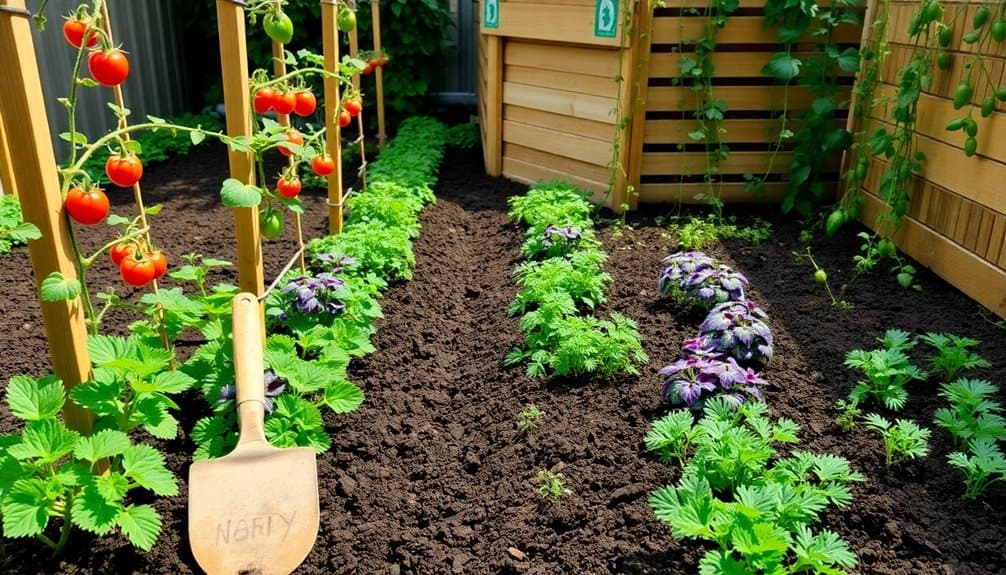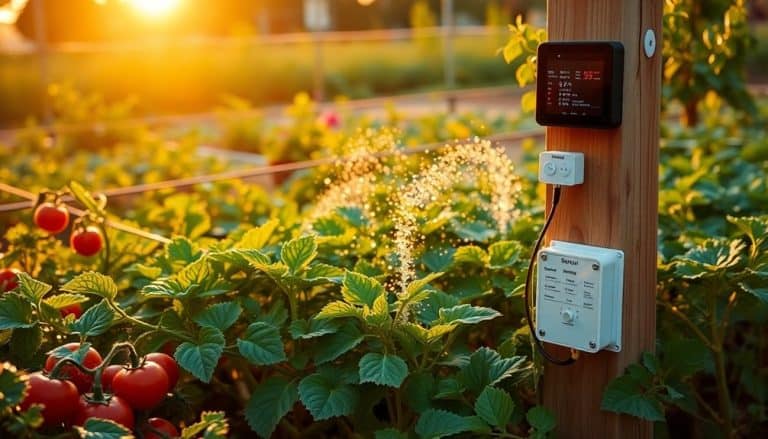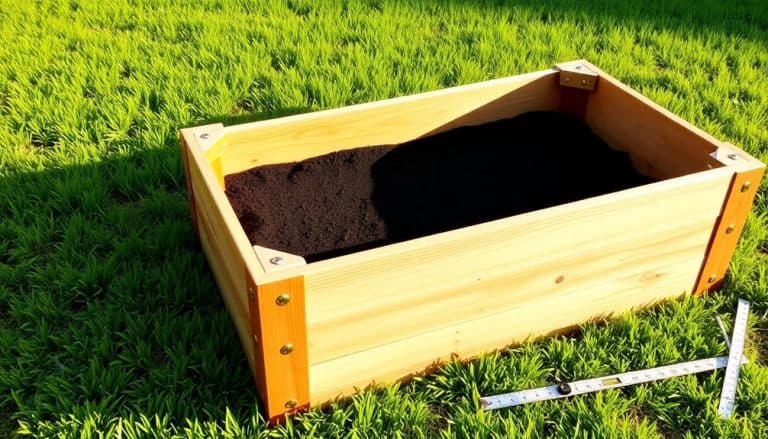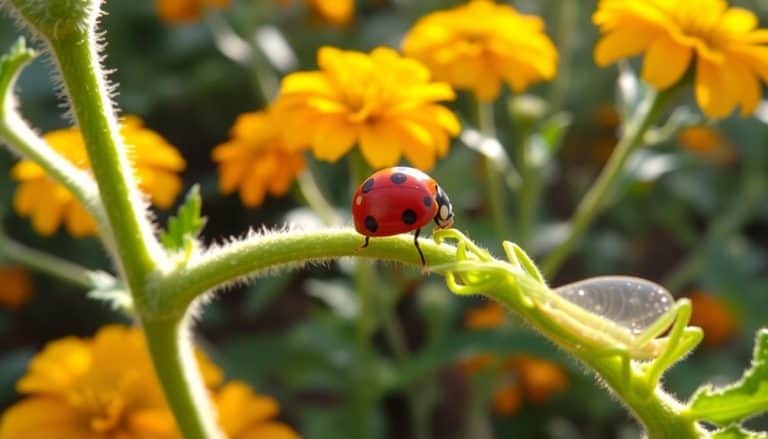This website contains affiliate links. Some products are gifted by the brand to test. As an Amazon Associate, I earn from qualifying purchases. The content on this website was created with the help of AI.
You’ll find organic gardening rewarding as you cultivate plants without synthetic chemicals or GMOs. Start by selecting a location with 6-8 hours of direct sunlight and testing your soil’s pH and nutrient levels. Build healthy soil through compost and aged manure while maintaining proper drainage. Invest in essential tools like spades, trowels, and reliable watering equipment. Practice natural pest management through companion planting and beneficial insects, and create a seasonal planting schedule aligned with your local frost dates. Water deeply but infrequently, and maintain detailed records of your garden’s progress. The journey to a thriving organic garden unfolds with each step you master.
Key Takeaways
- Start with healthy soil by adding organic matter, maintaining proper pH (6.0-7.0), and conducting soil tests for optimal growing conditions.
- Select a garden location with 6-8 hours of direct sunlight, good drainage, and easy access to water sources.
- Use essential tools like spades, trowels, and pruners while implementing proper watering techniques during early morning hours.
- Practice natural pest control through companion planting, beneficial insects, and organic deterrents like neem oil or garlic sprays.
- Plan seasonal plantings based on your hardiness zone, keeping detailed records of planting dates and garden outcomes.
Understanding Organic Garden Basics
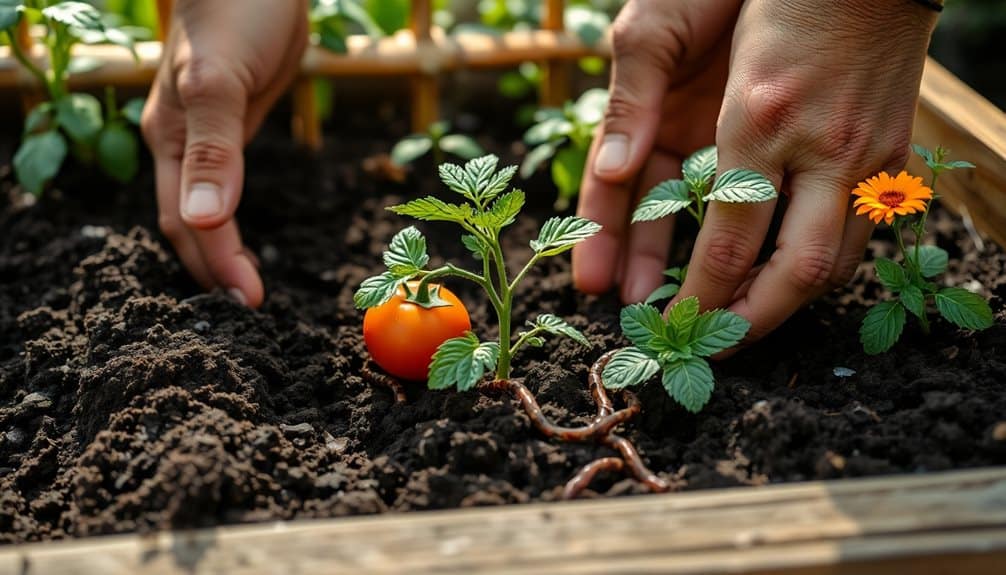
A thriving organic garden starts with understanding its fundamental principles. Organic gardening means cultivating plants without synthetic fertilizers, pesticides, or genetically modified organisms (GMOs). You’ll need to focus on building healthy soil, maintaining natural ecosystems, and working with nature’s cycles.
The foundation of organic gardening lies in soil health. You’ll want to create nutrient-rich soil by adding compost, aged manure, and organic matter. These materials feed beneficial microorganisms that break down nutrients for your plants. Test your soil’s pH and composition to understand what amendments it needs.
Natural pest management becomes essential in organic gardening. You’ll implement companion planting, where certain plants naturally repel pests while attracting beneficial insects. Create biodiversity by mixing different plant varieties and maintaining habitat for helpful creatures like birds and predatory insects.
Water management follows nature’s patterns in organic gardens. You’ll want to mulch soil to retain moisture, install drip irrigation for efficiency, and collect rainwater when possible. Understanding your climate zone and seasonal patterns helps you plan your garden’s layout and timing for best growth and harvest. Similar to maintaining proper water levels daily in indoor fountains, consistent monitoring of soil moisture is crucial for organic garden success.
Building Healthy Garden Soil
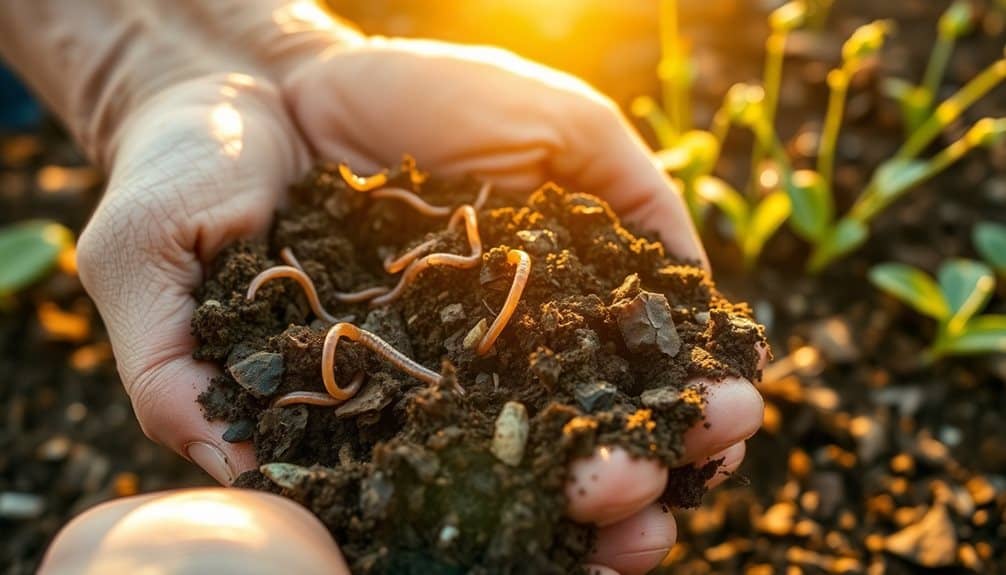
Healthy soil forms the lifeblood of your organic garden‘s success. It’s not just dirt – it’s a complex ecosystem teeming with beneficial microorganisms, nutrients, and organic matter. To build rich, fertile soil, you’ll need to focus on improving its structure, composition, and biological activity.
Start by conducting a soil test to determine your soil’s pH and nutrient levels. This analysis will guide your soil amendment strategy. You can then incorporate organic matter through composting, adding aged manure, or using cover crops. These practices enhance soil structure, water retention, and nutrient availability.
For accurate results, perform your soil nutrient testing at least twice during the growing season before applying any fertilizers.
- Add 2-3 inches of organic compost annually to increase soil fertility and improve texture
- Maintain soil pH between 6.0-7.0 for ideal nutrient absorption by most plants
- Use mulch to protect soil structure, retain moisture, and suppress weed growth
- Practice crop rotation to prevent nutrient depletion and reduce pest problems
Remember to avoid tilling whenever possible, as it disrupts soil structure and beneficial microorganism communities. Instead, use no-dig methods and focus on building soil from the top down. This approach mimics nature’s processes and creates a sustainable foundation for your organic garden.
Choosing Your Garden Location
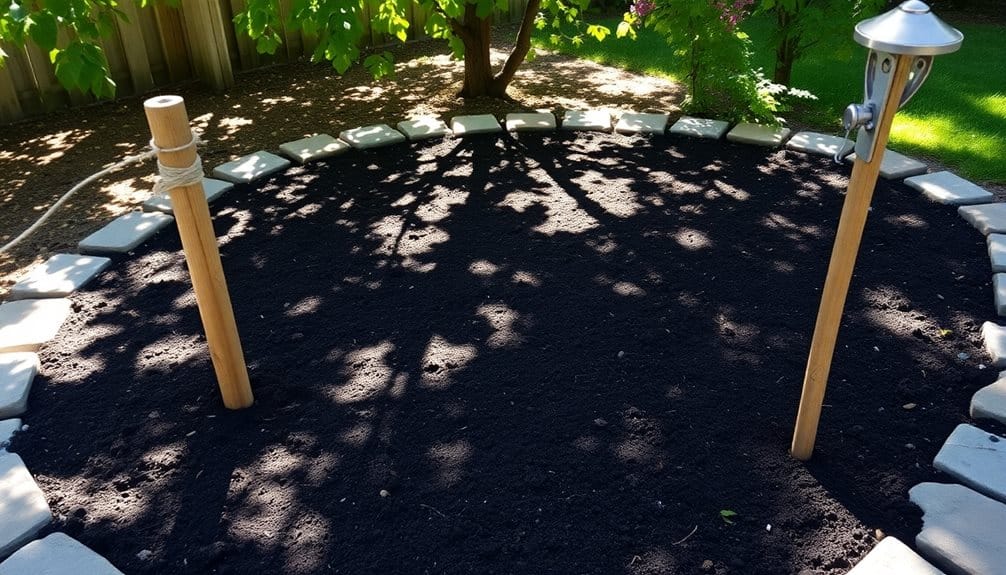
Selecting the right location for your organic garden sets the foundation for long-term success. You’ll need to evaluate several critical factors to determine the ideal spot for your plants to thrive. First, assess the sunlight patterns throughout the day – most vegetables require 6-8 hours of direct sunlight. Track sun exposure in potential locations during different seasons, noting any structures or trees that cast shadows.
Consider proximity to a reliable water source, as you’ll need consistent access for irrigation. Your garden should be within easy reach of outdoor spigots or rain barrels. The terrain’s topography matters too – avoid low-lying areas where water pools, and maintain proper drainage by selecting level ground or gentle slopes.
Factor in accessibility for maintenance tasks. You’re more likely to tend your garden regularly if it’s conveniently located. Don’t place it too far from your house or behind obstacles. Also, examine the surrounding environment – keep distance from large trees whose roots might compete for nutrients, and protect your plot from strong winds that could damage plants. If possible, position your garden where you can easily monitor it for pest issues and harvesting needs. When setting up your irrigation system, choose a high-pressure hose rated at 150-650 PSI to ensure strong water flow throughout your garden.
Essential Tools and Materials
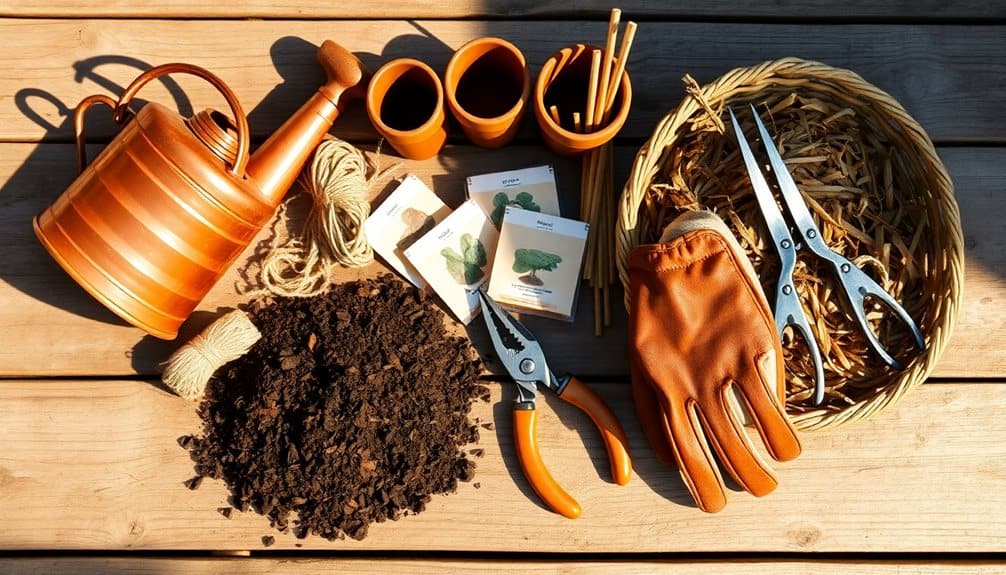
Starting your organic garden requires a core set of essential tools and materials that you’ll need for success. You’ll want to invest in quality tools that’ll last for years rather than cheap alternatives that’ll need frequent replacement. The basic toolkit should include hand tools for soil preparation, planting, and maintenance, along with materials for soil amendment and plant support.
For efficient gardening operations, you’ll need these fundamental items:
- A sturdy spade and garden fork for soil preparation, plus a hand trowel and cultivator for detailed work
- Pruning shears, garden scissors, and a sharp knife for plant maintenance and harvesting
- Organic materials including compost, mulch, and natural fertilizers derived from plant or animal sources
- Watering equipment including a reliable watering can and soaker hoses for efficient irrigation
Your local climate and specific plant choices may require additional specialized tools, but these core items will handle most gardening tasks. Remember to store your tools in a dry location and clean them after each use to prevent rust and extend their lifespan. Quality tools, when properly maintained, become reliable partners in your organic gardening journey. A well-organized plant care toolkit will help ensure you have everything needed for successful organic gardening.
Planning Your Organic Garden
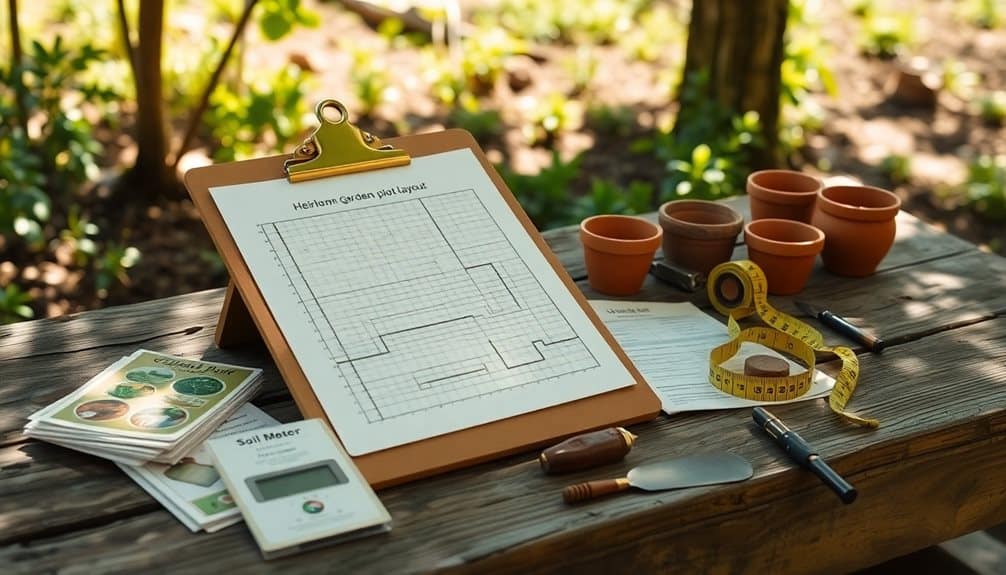
A garden’s success begins with thoughtful planning before the first seed touches soil. You’ll need to assess your growing zone, sun exposure, soil type, and available space to determine what you can realistically grow. Map out your garden’s layout on paper, considering mature plant sizes and companion planting relationships.
Select your growing location based on 6-8 hours of daily sunlight for most vegetables. Test your soil’s pH and composition, then plan necessary amendments to achieve the ideal 6.0-7.0 range for most crops. You’ll want to design garden beds no wider than 4 feet to guarantee easy access for maintenance.
Create a planting calendar that aligns with your region’s first and last frost dates. Group plants with similar water and nutrient needs together, and plan crop rotation to prevent soil depletion. Factor in succession planting to maximize your harvest throughout the growing season.
Don’t forget to include paths between beds and space for composting. Consider water sources and irrigation methods in your layout. If you’re starting small, focus on crops your family enjoys eating and those that offer the best value for your effort. Equip yourself with a heavy-duty tool set that includes essential implements like a trowel, pruning shears, and cultivator for efficient garden maintenance.
Natural Pest Management Methods
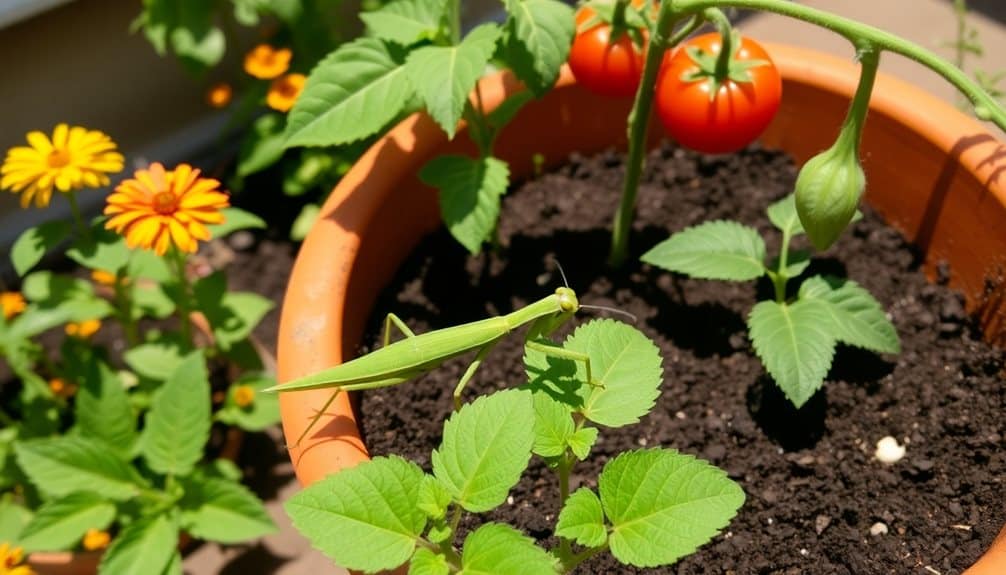
Protect your organic garden by creating a robust ecosystem that naturally deters harmful insects while attracting beneficial ones. You’ll find that companion planting with aromatic herbs like basil, marigolds, and lavender helps repel destructive pests. By incorporating diverse plant species, you’re establishing natural barriers that confuse and deter unwanted insects while providing habitat for helpful predators.
Physical barriers and biological controls form your first line of defense against common garden pests. You can install floating row covers to protect young plants, while introducing beneficial insects like ladybugs and praying mantises will help maintain nature’s balance.
- Create homemade insecticidal sprays using neem oil, garlic, or hot pepper solutions to target specific pest problems
- Maintain healthy soil through regular composting to strengthen plants’ natural resistance to pests
- Practice crop rotation to prevent pest populations from establishing permanent colonies
- Set up physical traps like sticky cards or diatomaceous earth barriers around vulnerable plants
When you notice pest damage, identify the culprit before taking action. Monitor your garden regularly and intervene early with the least toxic solution first, allowing natural predator-prey relationships to develop over time.
Watering and Maintenance Tips
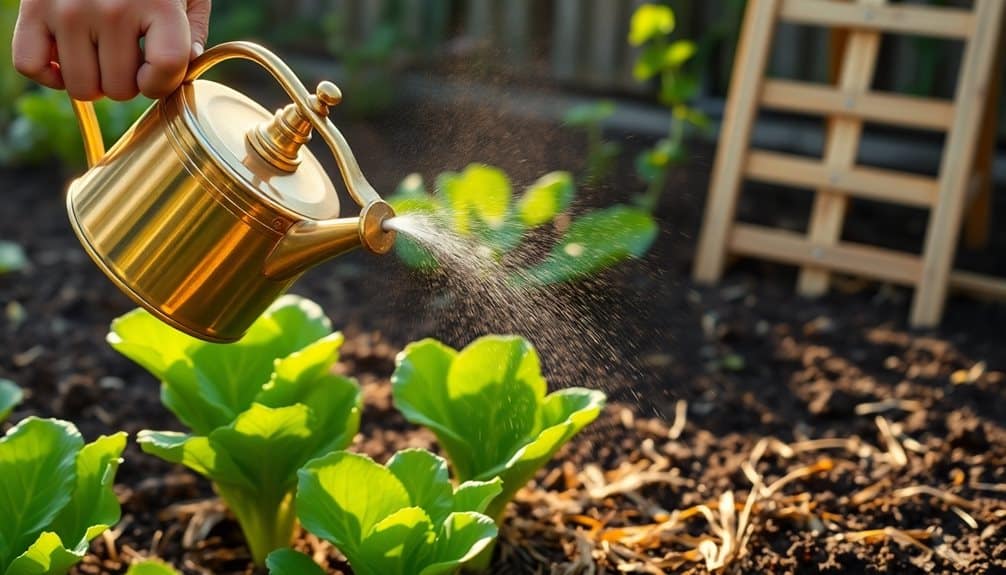
Building on your pest management strategy, proper watering techniques will strengthen your plants’ natural defenses. Water deeply but less frequently to encourage deep root growth. You’ll want to deliver water directly to the soil around plant bases, avoiding wet foliage that can promote fungal diseases. Early morning watering is ideal, allowing plants to dry before evening.
Install a drip irrigation system or soaker hoses to guarantee consistent moisture levels and water conservation. You’ll need to monitor soil moisture by inserting your finger 2-3 inches deep – if it’s dry at that depth, it’s time to water. Different plants require varying moisture levels, so group those with similar needs together.
For routine maintenance, remove spent blooms and yellowing leaves weekly to redirect energy to healthy growth. You’ll need to check for signs of nutrient deficiencies, indicated by leaf discoloration or stunted growth. Apply organic mulch 2-3 inches thick around plants, but keep it away from stems to prevent rot. Maintain proper spacing between plants to guarantee adequate airflow and reduce disease pressure. Test soil moisture before watering, especially after rainfall, to prevent overwatering.
Seasonal Planting Guide
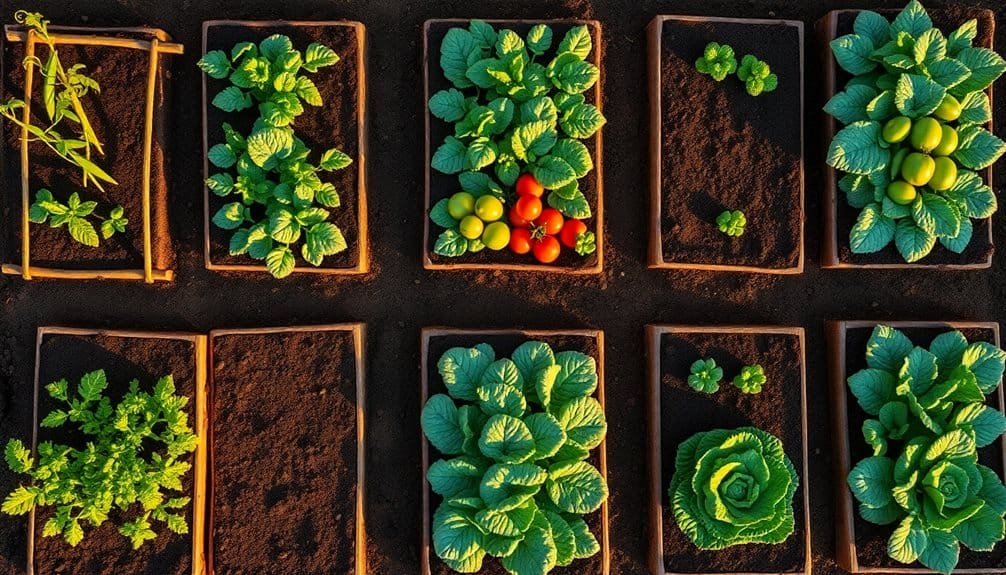
Understanding your region’s growing seasons forms the foundation of successful organic gardening. You’ll need to determine your specific USDA hardiness zone and familiarize yourself with your area’s first and last frost dates. These dates serve as essential benchmarks for planning your garden’s annual calendar.
To maximize your growing success throughout the year, divide your planting schedule into distinct seasonal windows. Cool-season crops thrive in spring and fall, while heat-loving plants flourish during summer months. You’ll want to start seeds indoors 6-8 weeks before transplanting outdoors, ensuring they’re ready when conditions are ideal.
- Spring (March-May): Plant peas, lettuce, spinach, and root vegetables as soon as soil can be worked
- Summer (June-August): Transfer heat-loving crops like tomatoes, peppers, and cucumbers after frost danger passes
- Fall (September-November): Start second plantings of cool-season vegetables for autumn harvest
- Winter (December-February): Focus on planning, soil preparation, and growing cold-hardy varieties in greenhouses or cold frames
Adapt your planting timeline based on local weather patterns and microclimate variations within your garden space. Keep detailed records of planting dates and outcomes to refine your schedule for subsequent seasons.
Frequently Asked Questions
Can I Convert My Existing Traditional Garden to Organic Without Starting Over?
Like trading your gas-guzzler for an electric car, you can shift your garden to organic without starting from scratch. You’ll need to stop using synthetic fertilizers and pesticides immediately, then begin enriching your soil with compost and organic matter. Let your soil recover for one growing season while you maintain it with natural mulch, organic amendments, and beneficial insects. You’re now on track for organic certification.
How Long Does It Take to Get Organic Certification for Home Gardens?
You don’t need organic certification for a home garden unless you’re planning to sell your produce commercially. If you do want certification, you’ll need to follow organic practices for three years and document that your soil hasn’t been treated with prohibited substances. The certification process involves extensive paperwork, inspections, and fees, typically ranging from $400 to $2,000, which isn’t practical or necessary for home gardeners.
Will Organic Gardening Cost More Than Conventional Gardening Methods?
Initially, you’ll spend more on organic seeds, natural fertilizers, and chemical-free pest control methods. However, you’ll save money long-term as you’ll create your own compost, collect seeds, and develop healthy soil that requires fewer inputs. While organic amendments might cost 20-30% more upfront, your garden will become self-sustaining, reducing yearly expenses compared to conventional methods that require constant chemical inputs.
Can I Save and Store Organic Seeds for Next Season’s Planting?
Yes, you can save and store organic seeds effectively. Let your healthiest plants fully mature until seeds are completely dry. You’ll need to harvest them on a dry day, clean off any plant debris, and guarantee they’re thoroughly dried before storage. Store your seeds in paper envelopes or airtight containers in a cool, dark, dry place at around 40°F. Properly stored seeds can remain viable for 2-5 years, depending on the variety.
Should I Join a Local Organic Gardening Community or Take Certification Courses?
Joining a local organic gardening community will give you hands-on experience, valuable mentorship, and regional growing insights you can’t find in books. You’ll learn area-specific techniques and can exchange seeds with experienced gardeners. While certification courses offer structured learning and credentials, they’re not essential for home gardening. Consider starting with community involvement and pursuing certification later if you plan to make organic gardening your profession.

